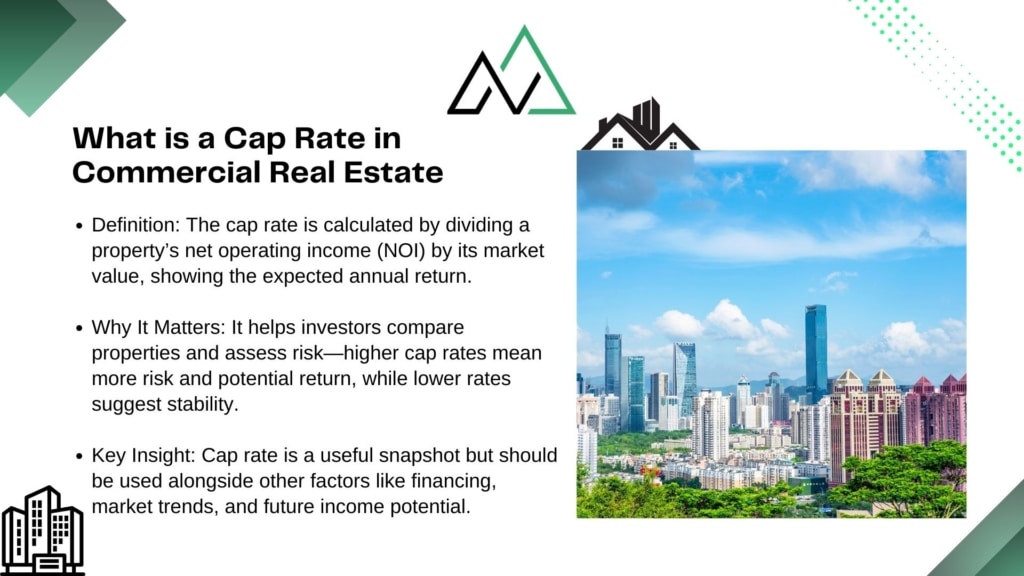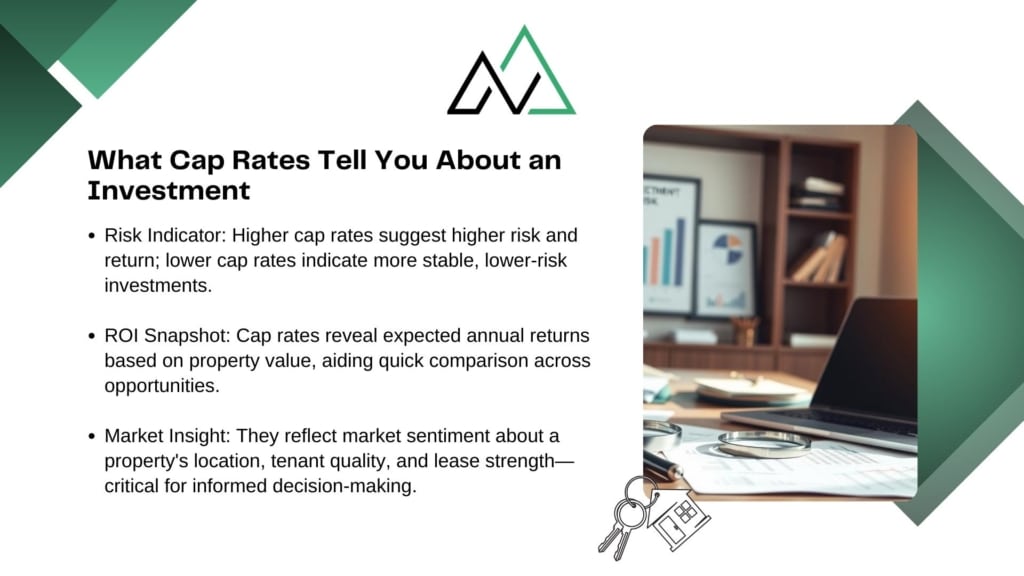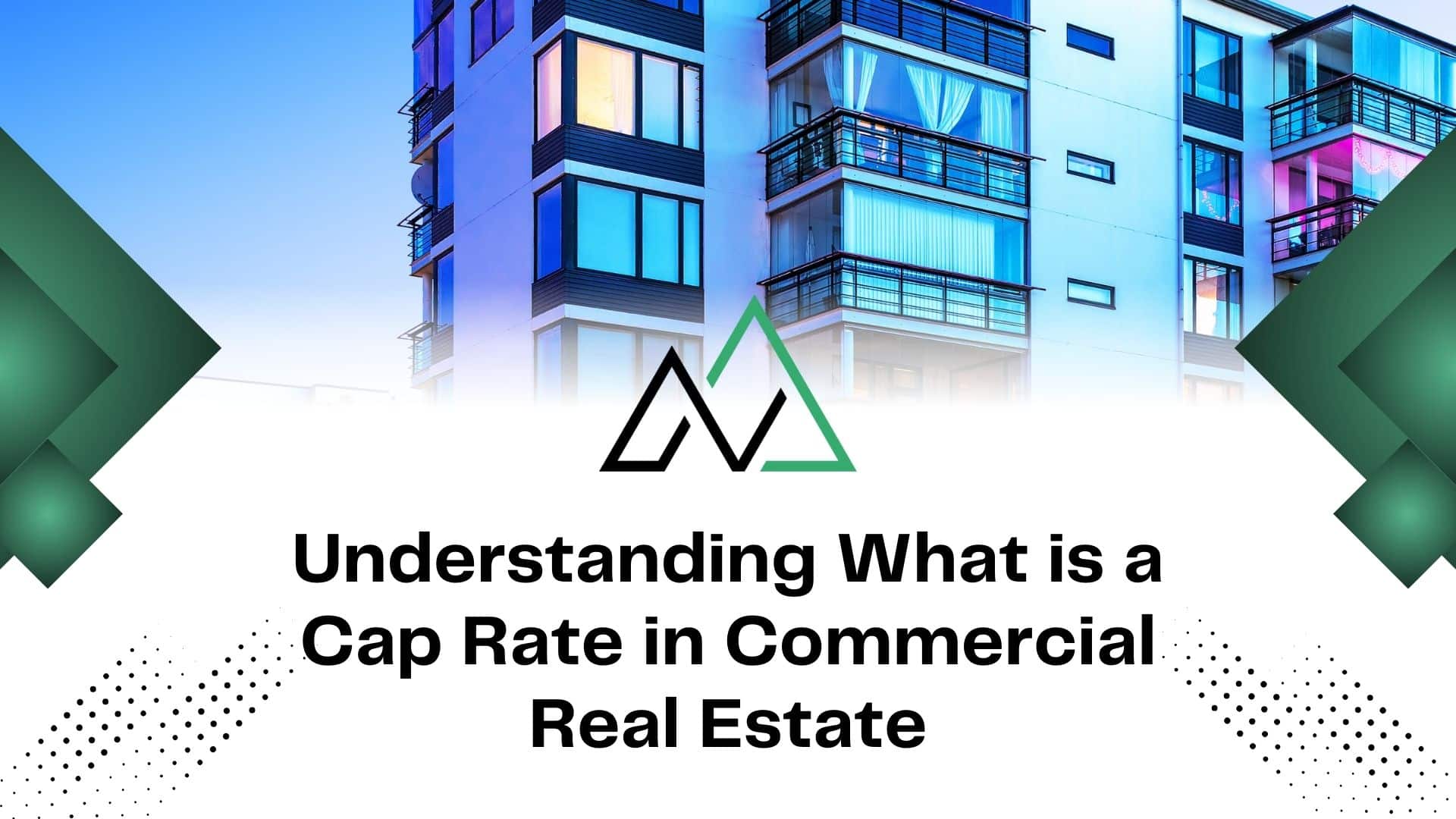Did you know that the capitalization rate, or cap rate, is a crucial metric in commercial real estate, helping investors gauge the potential return on investment for a property? With the Canadian commercial real estate market continuing to evolve, understanding cap rates is essential for making informed decisions.
New Homes Alberta, a trusted guide in the real estate industry, explains that the cap rate is calculated by dividing a property’s net operating income by its current market value. This metric allows investors to compare different properties on an equal footing, assessing potential returns and risks associated with their investments.
As investors navigate the complex world of commercial real estate, understanding cap rates can help them make strategic decisions based on their financial goals and risk tolerance. For expert guidance on using cap rates to evaluate commercial real estate investments, contact New Homes Alberta at (403)305-9167.
Key Takeaways
- Cap rates serve as a fundamental metric in commercial real estate investment.
- Understanding cap rates helps investors make informed decisions in the real estate market.
- Cap rates function as a risk assessment tool, enabling investors to compare properties.
- New Homes Alberta offers expert guidance on using cap rates for investment decisions.
- Cap rates provide critical insights into a property’s potential performance.
What is a Cap Rate in Commercial Real Estate
For investors, grasping the concept of cap rate is essential for navigating the complexities of commercial real estate investment. The cap rate, or capitalization rate, is a metric used to evaluate the potential return on investment for a commercial property.
Definition and Basic Concept
The cap rate is calculated by dividing the property’s net operating income (NOI) by its current market value. This ratio provides investors with a quick snapshot of a property’s potential yield, allowing for efficient comparison between multiple investment opportunities. For instance, a property with an NOI of $100,000 and a market value of $1,000,000 has a cap rate of 10%. Understanding this concept is vital for investors to determine if a property’s expected return aligns with their risk tolerance and investment strategy.
| Property | NOI | Market Value | Cap Rate |
| Apartment Building | $100,000 | $1,000,000 | 10% |
| Office Space | $50,000 | $500,000 | 10% |
Why Cap Rates Matter to Investors
Cap rates matter to investors because they signal a property’s risk profile. Generally, higher cap rates suggest higher risk but potentially higher returns, while lower cap rates indicate lower risk but typically lower returns. Investors use cap rates to establish appropriate purchase prices for commercial properties based on the income they generate rather than arbitrary market valuations. By understanding cap rates, investors can communicate effectively with brokers, lenders, and other stakeholders using a standardized industry metric.

While the cap rate can be useful for quickly comparing the relative value of similar real estate investments, it should not be used as the sole indicator of an investment’s strength. Other factors such as leverage, the time value of money, and future cash flows from property improvements should also be considered.
How Cap Rates Are Calculated
To assess the viability of a commercial property investment, it’s essential to know how to calculate cap rates accurately. The cap rate is a critical metric that helps investors understand the potential return on investment.
The Cap Rate Formula
The cap rate is calculated using a straightforward formula: Cap Rate = Net Operating Income (NOI) / Property Value. This formula provides a percentage that represents the return on investment. For instance, if a property has an NOI of $100,000 and a value of $1,000,000, the cap rate would be 10%. Understanding this formula is crucial for investors to compare different investment opportunities.

Net Operating Income Explained
Net Operating Income (NOI) is a vital component in calculating cap rates. It represents the annual revenue generated by a property after deducting all operating expenses but before accounting for debt service, income taxes, and capital expenditures. To calculate NOI, one must identify all potential income sources, such as base rent, additional rent, and parking fees, and then subtract all operating expenses, including property taxes, insurance, maintenance, and property management.
Accurate NOI calculation is critical because it provides a clear picture of a property’s operational performance, independent of its financing. Common mistakes in NOI calculations include failing to account for vacancy rates or underestimating operating expenses. For investors, conducting thorough due diligence to verify income and expense figures is essential when evaluating potential commercial real estate investments.
What Cap Rates Tell You About an Investment
The cap rate is a key indicator that helps investors assess the viability of a commercial real estate investment. It provides a snapshot of the property’s potential return on investment, allowing investors to compare different opportunities.
Risk Assessment
Cap rates are instrumental in risk assessment, as they indicate the level of return an investor can expect relative to the investment’s risk. A higher cap rate often signifies higher risk, while a lower cap rate suggests a more stable investment. For instance, a property with a cap rate of 10% is considered riskier than one with a 7% cap rate. Investors use cap rates to balance their risk tolerance with potential returns.
When evaluating risk, consider that cap rates reflect the market’s perception of the property’s risk. A higher cap rate may indicate a riskier investment, potentially due to factors like location, property condition, or tenant quality. Conversely, a lower cap rate may suggest a more stable investment, possibly due to a prime location or a strong, long-term lease with a creditworthy tenant.

Return on Investment Potential
Cap rates offer a straightforward measure of a property’s potential return on investment, indicating the annual percentage yield an investor might expect. For example, a property with a 7% cap rate generates annual returns equal to 7% of the property’s value. This metric allows investors to compare different investment opportunities directly.
Investors should also consider how cap rates compare to returns available from alternative investments, such as bonds, stocks, or other real estate opportunities. New Homes Alberta advises clients to consider both current returns (represented by the cap rate) and potential future appreciation when assessing the overall return potential of commercial real estate investments. This comprehensive approach helps investors make informed decisions that align with their financial goals.
Good vs. Bad Cap Rates: What to Look For
Understanding the nuances of cap rates is crucial for investors to make informed decisions in commercial real estate. The cap rate, or capitalization rate, is a key metric that helps investors evaluate the potential return on investment (ROI) for a property.
When assessing whether a cap rate is good or bad, several factors come into play. Generally, a lower cap rate indicates a more valuable property with potentially lower returns but also lower risk. Conversely, a higher cap rate suggests a riskier investment with potentially higher returns.
Cap Rate Ranges by Market
Cap rate ranges can vary significantly by market. For instance, “trophy” properties in prime locations typically command lower cap rates due to their stability and lower risk profile. In contrast, properties in emerging markets or those requiring significant renovations may have higher cap rates to compensate for the increased risk.
- Lower cap rates are often associated with prime locations and stable, long-term leases.
- Higher cap rates may be seen in emerging markets or properties with higher risk profiles.
- Investors with different strategies may target specific cap rate ranges based on their investment goals.
When Higher or Lower Cap Rates Make Sense
The context in which a cap rate is considered “good” or “bad” depends on various factors, including the investor’s strategy, market conditions, and the property’s characteristics. For example, value-add investors may seek higher cap rate properties to maximize returns through renovations or repositioning.
In conclusion, understanding the nuances of cap rates and their implications is vital for making informed investment decisions. Whether a higher or lower cap rate is more appropriate depends on the investor’s goals, risk tolerance, and market conditions.
Factors That Influence Cap Rates
The cap rate of a commercial property is not determined in isolation; rather, it’s influenced by a complex interplay of various market and property-specific factors. Understanding these factors is essential for investors to make informed decisions.
Location and Market Conditions
Location and market conditions play a pivotal role in determining cap rates. Properties situated in prime locations with strong demand tend to have lower cap rates due to their lower risk profile.
Conversely, properties in less desirable locations or those with higher vacancy rates may command higher cap rates to compensate for the increased risk. Market conditions, including the overall state of the economy, interest rates, and the supply and demand for commercial real estate, also significantly impact cap rates.
Property Type and Class
The type and class of a property are also critical factors influencing cap rates. Different property types, such as office buildings, retail centers, or industrial facilities, have varying risk profiles and growth potential, which affect their cap rates.
Similarly, the property’s class, which reflects its age, condition, and amenities, impacts its attractiveness to tenants and investors, thereby influencing its cap rate.
Tenant Quality and Lease Terms
Tenant quality and lease terms are significant determinants of cap rates. Properties leased to creditworthy tenants with long-term leases are generally considered less risky and may have lower cap rates.
- Tenant quality significantly impacts cap rates, with investment-grade tenants commanding lower rates.
- Lease terms, including duration and rent escalation provisions, directly influence cap rates by affecting income stream predictability.
- Triple-net leases often result in lower cap rates due to reduced landlord obligations.
Investors must carefully evaluate these factors when assessing cap rates to make informed investment decisions.
The Relationship Between Cap Rates and Interest Rates
Understanding the dynamic between cap rates and interest rates is crucial for investors navigating the commercial real estate market. The relationship between these two financial metrics can significantly impact investment decisions and property valuations.
How Interest Rate Changes Affect Cap Rates
Interest rate fluctuations can directly influence cap rates. When interest rates rise, the cost of borrowing increases, which can lead to higher cap rates as investors seek higher returns to offset the increased borrowing costs. Conversely, when interest rates fall, cap rates may decrease as the cost of borrowing becomes cheaper, making investments more attractive at lower returns.
Current Market Trends: In 2024, cap rates increased nationally, but at a slower pace than in the prior year. According to CoStar data, multifamily, industrial, and office cap rates saw increases of 0.4% or more between Q2 2023 and Q3 2024.
| Property Type | National Average Cap Rate (%) |
| Multifamily | 6.1 |
| Industrial | 7.6 |
| Office | 8.9 |
| Retail | 7.0 |
Current Market Trends in Canada
The Canadian commercial real estate market has experienced cap rate expansion, particularly in the office sector, due to changing work patterns and occupancy challenges. Alberta’s markets have shown resilience, supported by the province’s economic recovery and population growth.
Market participants anticipate potential cap rate compression in the coming years if interest rates decline as expected, potentially creating favorable conditions for property acquisitions.
Cap Rates Across Different Property Types
Understanding cap rates across various property types is crucial for investors seeking to optimize their portfolios. Different property classes exhibit unique cap rate characteristics, influenced by factors such as location, market trends, and property-specific attributes.
Multifamily Properties
Multifamily properties, including apartment buildings, typically offer stable returns due to consistent demand for housing. Cap rates for multifamily properties can range from 4% to 7%, depending on factors like location, property age, and amenities. For instance, luxury apartments in urban centers may have lower cap rates, around 4%, while more affordable or suburban properties might offer higher cap rates, up to 7%.
Office Buildings
Office buildings present a different cap rate landscape, influenced by factors such as tenant quality, lease terms, and building class. High-quality office spaces in prime locations may have cap rates between 5% to 6%, while older or less desirable buildings might see cap rates of 8% or higher. The rise of remote work has also impacted office building cap rates, with some areas experiencing increased vacancy rates.
Retail Properties
Retail properties, including shopping centers and standalone stores, have cap rates that vary based on factors like location, tenant mix, and lease terms. Cap rates for retail properties can range from 6% to 9%, with higher rates often associated with riskier or less desirable locations. The shift to e-commerce has also affected retail cap rates, with some properties requiring significant repositioning or redevelopment.
Industrial Properties
Industrial properties have experienced significant cap rate compression in recent years due to strong demand from e-commerce, logistics, and manufacturing tenants. As of Q3 2024, industrial cap rates averaged around 7.6% nationally, with variations by city, such as Los Angeles at 5.3%, San Francisco at 5.9%, New York at 6.3%, and Chicago at 8.3%. Modern distribution facilities in prime logistics corridors may trade at cap rates in the 5-6% range, while older manufacturing facilities or secondary locations might command cap rates of 8% or higher.
As Forbes notes, “The industrial sector’s strong fundamentals, including limited new supply and growing demand, have attracted significant institutional investment, putting downward pressure on cap rates.” This trend is expected to continue, making industrial properties an attractive investment opportunity at competitive cap rates.
Practical Examples of Cap Rate Calculations
To grasp the practical application of cap rates, let’s examine a couple of real-world examples. These will illustrate how cap rates are used to evaluate different types of properties.
Apartment Building Investment
Consider an apartment building with a net operating income (NOI) of $50,000, expected to increase by 2% annually. If the investor’s required rate of return is 10%, the cap rate would be 8% (10% – 2%). Using the cap rate formula, the property’s value is calculated as $50,000 / 0.08 = $625,000.
| Net Operating Income | Cap Rate | Property Value |
| $50,000 | 8% | $625,000 |
Commercial Office Space
Now, let’s examine a commercial office building with an asking price of $4,000,000, generating $500,000 in annual rental income and having $200,000 in operating expenses, resulting in an NOI of $300,000. The cap rate is calculated as $300,000 / $4,000,000 = 0.075 or 7.5%.
- If comparable office properties are trading at cap rates of 8-9%, this property might be considered overpriced.
- However, if the property has superior tenants or longer lease terms, the lower cap rate might be justified.
These examples demonstrate how cap rates can be used to compare investment opportunities and make informed decisions in commercial real estate.
Limitations of Using Cap Rates
While cap rates serve as a valuable metric for evaluating commercial real estate investments, they have inherent limitations that investors must consider. Cap rates provide a snapshot of an investment’s potential return based on the net operating income and the property’s value. However, they do not account for various critical factors that can impact the overall performance of the investment.
When Cap Rates Don’t Tell the Full Story
Cap rates are based on current income and property value, but they don’t take into account future risks such as depreciation or structural changes in the rental market that could cause income fluctuations. Investors should consider these risks when relying on cap rate calculations. For instance, a property with a high cap rate might be in a market that’s prone to significant fluctuations, potentially jeopardizing future returns.
Other Metrics to Consider
To get a comprehensive view of an investment’s potential, investors should consider additional metrics alongside cap rates. These include:
- Cash-on-cash return, which provides insight into actual cash flow relative to invested equity.
- Internal Rate of Return (IRR), accounting for the time value of money and projected changes in income and property value.
- Debt Service Coverage Ratio (DSCR), measuring a property’s ability to cover its debt obligations.
- Gross Rent Multiplier (GRM), offering a quick assessment of property value relative to gross income.
| Metric | Description | Usefulness |
| Cash-on-cash return | Actual cash flow relative to invested equity | High |
| Internal Rate of Return (IRR) | Comprehensive return metric considering time value of money | High |
| Debt Service Coverage Ratio (DSCR) | Property’s ability to cover debt obligations | High |
| Gross Rent Multiplier (GRM) | Quick assessment of property value relative to gross income | Medium |
By considering these metrics in conjunction with cap rates, investors can make more informed decisions about their commercial real estate investments.
Conclusion: Making Informed Investment Decisions with Cap Rates
To succeed in commercial real estate investing, one must understand the significance of cap rates. Cap rates serve as a valuable starting point for investment analysis, providing a standardized metric for comparing different properties and markets. Successful investors recognize both the utility and limitations of cap rates, supplementing them with additional financial metrics and thorough due diligence to make well-informed investment decisions.
The most effective approach to using cap rates involves understanding their relationship to risk, return expectations, and broader market conditions. New Homes Alberta provides comprehensive support for commercial real estate investors, helping clients navigate cap rate considerations and other critical factors in the investment decision-making process.
For personalized guidance on commercial real estate investments and expert analysis of cap rates in Alberta markets, contact New Homes Alberta at (403)305-9167 to discuss your investment goals and opportunities.
FAQ
How do I determine a good capitalization rate for my investment property?
A good capitalization rate varies by market, property type, and other factors. Generally, a cap rate between 4% and 12% is considered acceptable, but it’s essential to evaluate it in the context of the local market and property specifics.
What factors influence the cap rate of a property?
The cap rate is influenced by several factors, including location, property type and class, tenant quality, lease terms, and overall market conditions. Understanding these factors helps investors make informed decisions.
How do interest rates affect cap rates?
Interest rates and cap rates are closely related. When interest rates rise, cap rates tend to increase as well, as investors seek higher returns to offset the increased borrowing costs. Conversely, lower interest rates can lead to lower cap rates.
Can cap rates be used as the sole metric for evaluating an investment?
No, cap rates should not be used in isolation. While they provide valuable insights into an investment’s potential return, other metrics, such as cash flow, gross yield, and internal rate of return, should also be considered to get a comprehensive picture.
How do different property types affect cap rates?
Different property types, such as multifamily, office, retail, and industrial, have varying cap rates due to their unique characteristics, market demand, and risk profiles. Understanding these differences is crucial for investors.
What is the relationship between net operating income and cap rate?
Net operating income (NOI) is a critical component in calculating the cap rate. A higher NOI can result in a more attractive cap rate, as it indicates a property’s potential to generate more income relative to its value.
How do market conditions impact cap rates?
Market conditions, including supply and demand, economic trends, and local factors, can significantly impact cap rates. Investors should stay informed about market conditions to make informed decisions.





